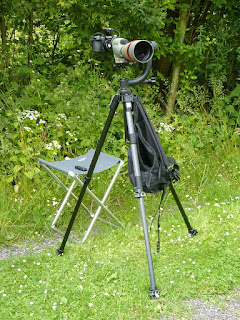~~

 Following my failure to reach infinity focus with the original camera adapter I had ordered a much shorter example from Baader.
Following my failure to reach infinity focus with the original camera adapter I had ordered a much shorter example from Baader.The new ring is 19mm long compared to 35mm. The ring arrived in the post and I hastened to fit it between the telescope and the camera.
Sadly it still would not reach infinity focus by a long way. 10 yards was the maximum target distance which could obtain sharp focus.

 With the Kowa 1.6 Extender fitted I could just reach focus on a tree at 100 yards but no more. See image below left.
With the Kowa 1.6 Extender fitted I could just reach focus on a tree at 100 yards but no more. See image below left.By the way, the image was upside down. Easily corrected in image handling software but difficult to find targets in the live viewfinder.
The next test was the macro capability. Without the Extender the nearest focus was about 3-4 yards. A bright and sharp image but with a very shallow depth of field. With the extender it was worse. Finding an object, like a flower or butterfly was very difficult with the image upside down.

 Well, I now have a range of options for fitting 1.25" and T2 threaded equipment directly to the Lumix camera body. I could have gone on experimenting and tried my range of GPCs but decided against it.
Well, I now have a range of options for fitting 1.25" and T2 threaded equipment directly to the Lumix camera body. I could have gone on experimenting and tried my range of GPCs but decided against it.There is a gap of a couple of millimetres visible between the adapters. Closing that down would require the end of the 1.25" adapter be shortened. A few minutes work in the lathe. How much extra distance reach that would provide is an unknown. Though it must all help.
It did, but only a little. Removing 3mm from the 1.25" nosepiece meant I could reach focus at about 105 yards, with the 1.6x Extender, but things still went soft beyond that. Without the extender I was limited to about 8 yards.
As a macro, or telephoto lens, the results were very mixed. Having the image inverted is a real nuisance and completely spoils the fun. Having such a high power, with the 1.6x extender in place, makes it even more difficult to find anything. Not to mention keeping everything still with such a long focal length! Probably 800mm equivalent in Micro 4/3 terms. 1600mm in 35mm? Crackers!
So it's back to using a camera lens with the Kowa zoom eyepiece and DA-10 adapter. Or without the camera lens and using the Kowa PA7 adapter over the zoom. In both cases I still have much to learn about camera settings to get the exposures short enough to freeze any motion. I know what I should be doing but getting the camera to obey is quite another matter.
As a final test of reaching focus I tried my specialist ZWO astro cameras. These are T2-1.25" mounted and failed similarly to the Lumix G9 to reach focus at any great distance. Fitting the 1.6x extender allowed me to reach a 100 yard distant tree but it was right on the limit. Anything beyond that was out of focus. The image scale was huge due to the tiny sensor size. Since the image scale was already completely impractical I found that fitting any of the GPCs was hardly worth the effort.
~





























